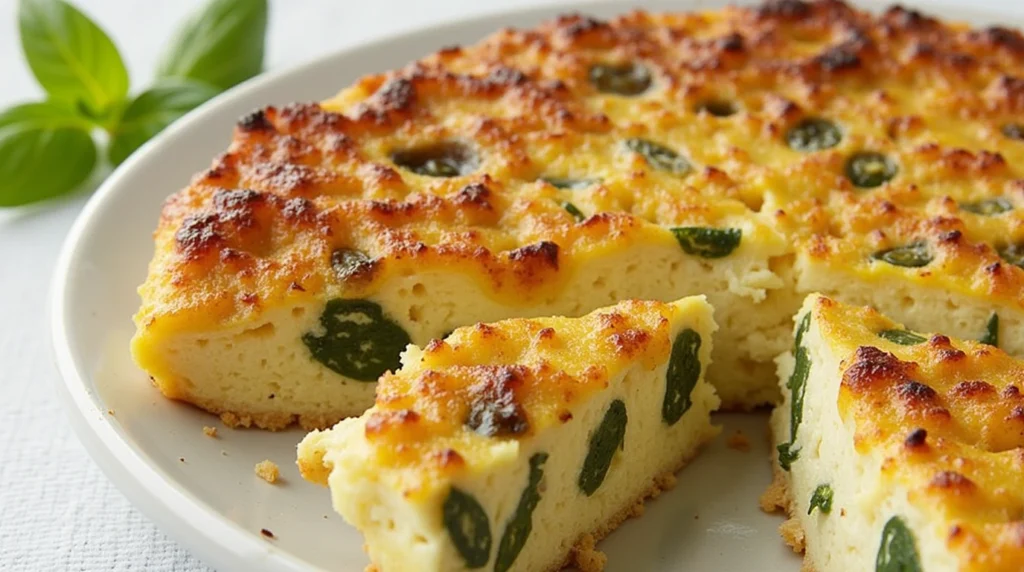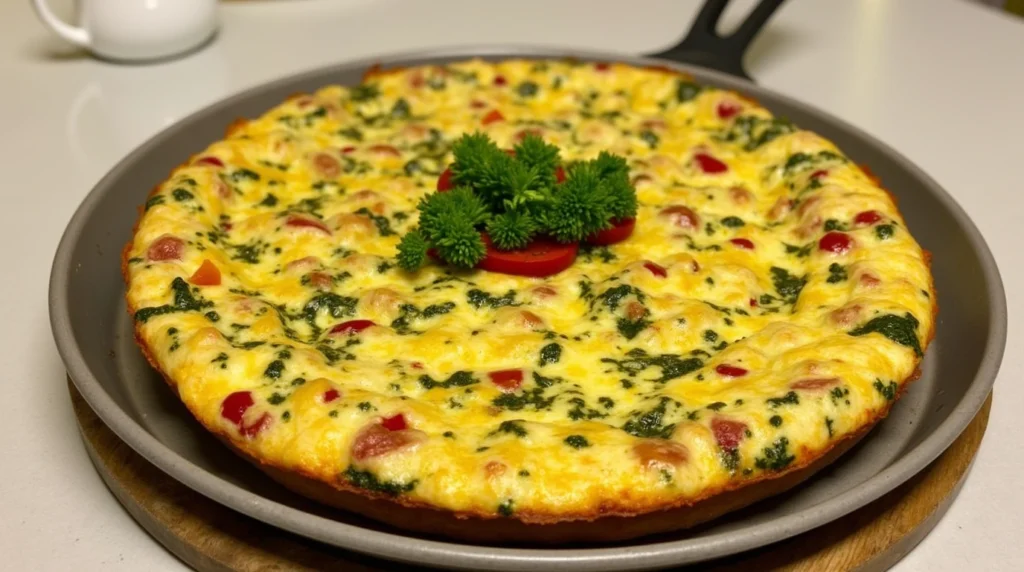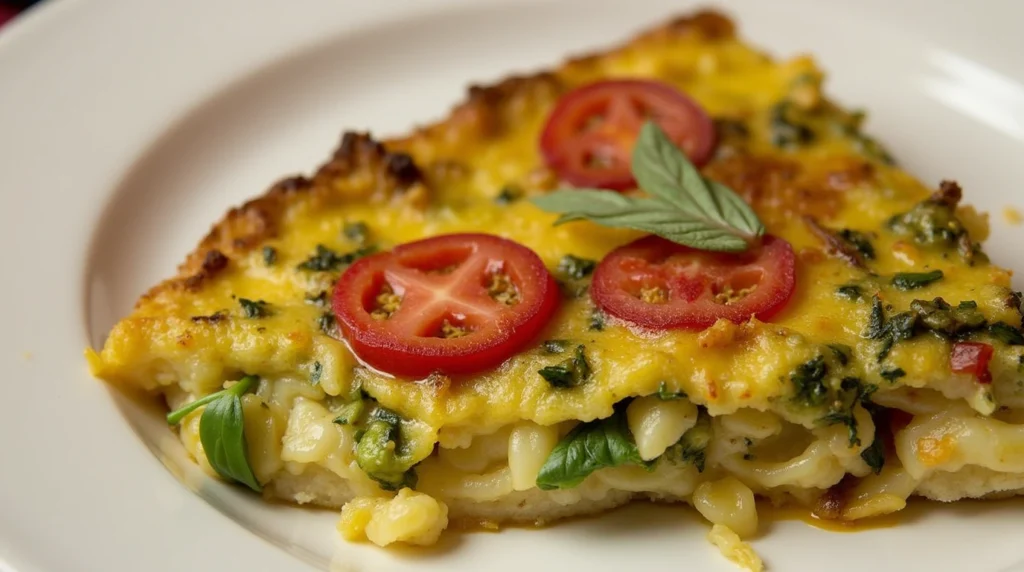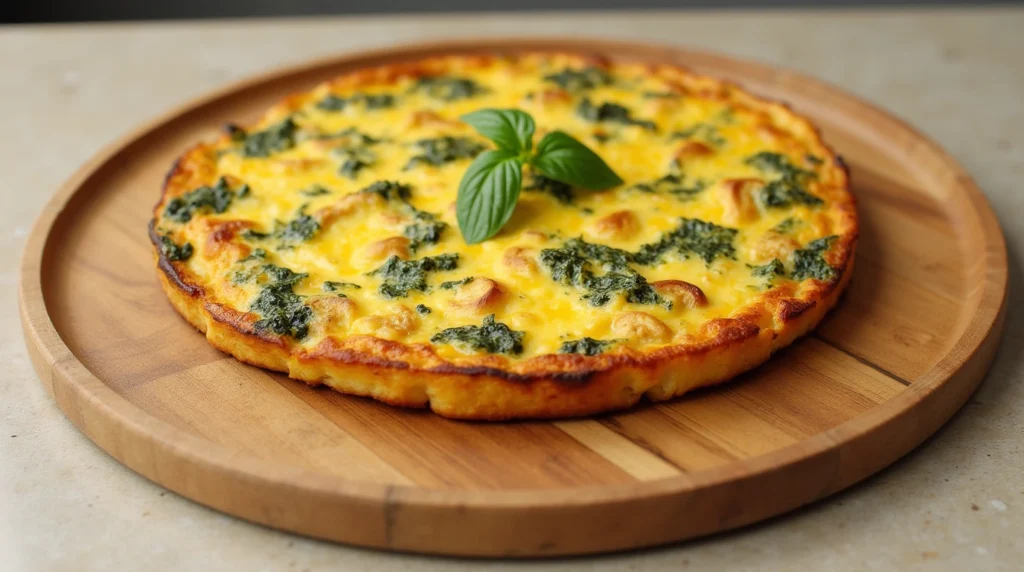Introduction

Imagine this: You’re standing in your kitchen on a busy weekday morning, debating what to make for breakfast. Should you whip up a quick omelette or take the time to bake a hearty frittata? Both options sound delicious, but which one is better for your health? This question has puzzled many home cooks and nutrition enthusiasts alike. Let’s dive into the debate between frittata and omelette to uncover their nutritional secrets and help you decide which dish aligns with your lifestyle.
You might already know that eggs are packed with essential nutrients, but how do these two popular egg-based meals compare when it comes to calories, protein, fats, and overall health benefits? Whether you’re looking for something quick and easy or a dish that can last through the week, we’ve got all the answers right here. By the end of this article, you’ll have a clearer understanding of whether frittata or omelette reigns supreme—or if there’s room for both in your diet.
Understanding the Basics of Frittata and Omelette
Definition of Frittata
Frittata is an Italian staple that combines beaten eggs with vegetables, cheese, and sometimes meat, cooked slowly on the stovetop and finished in the oven. Unlike scrambled eggs, frittatas are typically baked until golden brown, giving them a rich, custard-like texture.
- Origins : Rooted in Italian cuisine, frittatas were originally created as a way to use leftover ingredients.
- Differences from Scrambled Eggs : While scrambled eggs are soft and fluffy, frittatas are denser and more substantial.
- Common Ingredients : Spinach, tomatoes, bell peppers, mushrooms, and Parmesan cheese are often used in traditional recipes.
Definition of Omelette
On the other hand, omelettes hail from France and are known for their delicate folding technique. They’re usually cooked quickly on high heat and filled with ingredients like cheese, herbs, and vegetables before being folded neatly onto a plate.
- Origins : French chefs developed the art of making omelettes centuries ago, emphasizing simplicity and elegance.
- Folding Technique : The key to a perfect omelette lies in its smooth, even fold, creating a visually appealing presentation.
- Popular Fillings : Cheese, spinach, chives, and mushrooms are common choices for enhancing flavor.
Key Differences Between Frittata and Omelette
While both dishes share similarities, they differ significantly in preparation methods and textures:
- Cooking Method : Frittatas require slower cooking on the stovetop followed by baking in the oven, whereas omelettes are cooked rapidly over high heat.
- Texture Variations : Frittatas tend to be firmer and denser, while omelettes are lighter and fluffier.
- Portion Sizes : Due to their baking process, frittatas can serve multiple people at once, making them ideal for brunch gatherings.
Nutritional Comparison of Frittata vs Omelette
Calorie Count
Let’s break down the calorie content of each dish:
| Meal | Basic Recipe (Calories) | With Cheese & Veggies |
|---|---|---|
| Frittata | 200–250 per serving | 300–400 per serving |
| Omelette | 150–200 per serving | 250–350 per serving |
- Adding extra ingredients such as cheese, cream, or butter will increase the calorie count.
- Opt for low-fat alternatives to keep your meal lighter without sacrificing taste.
Protein Content
Both frittata and omelette are excellent sources of high-quality protein, thanks to the eggs:
- A single large egg contains approximately 6 grams of protein.
- Including protein-rich fillings like turkey, chicken, or tofu can boost the total protein content further.
Protein plays a vital role in muscle repair, energy production, and maintaining satiety throughout the day.
Fat and Cholesterol Levels
Eggs naturally contain healthy fats, including omega-3 fatty acids, which support heart health. However, moderation is key:
- One large egg has about 186 mg of cholesterol.
- To lower cholesterol levels, consider using egg whites instead of whole eggs.
Vitamins and Minerals
Eggs are nutrient powerhouses, providing essential vitamins and minerals like vitamin D, B vitamins, selenium, and iodine. Vegetables added to either dish enhance its nutritional profile:
- Spinach delivers iron and antioxidants.
- Bell peppers provide vitamin C.
- Mushrooms contribute vitamin B6.
Customization Options for Healthier Meals
Low-Calorie Variations
If you’re watching your calorie intake, here are some tips for healthier versions:
- Use fewer eggs or substitute some with egg whites.
- Choose reduced-fat cheeses or skip them entirely.
- Replace heavy cream with skim milk or almond milk.

Veggie-Packed Recipes
Incorporating nutrient-dense vegetables not only lowers the calorie count but also increases fiber and micronutrient content:
- Try adding spinach, kale, zucchini, or broccoli to your frittata or omelette.
- Here’s a simple recipe idea:
- Ingredients : 4 eggs, 1 cup chopped spinach, ½ cup diced tomatoes, ¼ cup grated Parmesan.
- Instructions : Beat the eggs, mix in the spinach and tomatoes, pour into a greased skillet, and cook until set. Sprinkle with Parmesan before serving.
Gluten-Free and Dairy-Free Adaptations
For those with dietary restrictions, here’s how to adapt these dishes:
- Use gluten-free flour for binding if needed.
- Substitute dairy with plant-based alternatives like coconut yogurt or vegan cheese.
Which One Fits Your Lifestyle Better?
Quick Weeknight Dinners
Omelettes shine as a go-to option for busy nights because they’re fast and easy to prepare:
- Crack a couple of eggs into a bowl, whisk, add your favorite fillings, and cook within minutes.
- Keep pre-chopped veggies in the fridge for effortless assembly.
Meal Prep and Leftovers
Frittatas excel in meal prep scenarios due to their ability to feed several people at once:
- Bake a large frittata on Sunday and enjoy slices throughout the week.
- Store leftovers in the refrigerator and reheat in the microwave or toaster oven.
Special Occasions and Brunch Ideas
When hosting brunches or special events, frittatas make an impressive centerpiece:
- Customize flavors with gourmet ingredients like truffle oil, smoked salmon, or arugula.
- Serve alongside fresh fruit salad or whole-grain bread for a balanced meal.
Final Verdict – Is One Truly Healthier Than the Other?
Balanced Perspective
Ultimately, both frittata and omelette can fit into a healthy diet depending on how they’re prepared:
- Focus on portion sizes and ingredient quality to maximize nutritional benefits.
- Avoid excessive amounts of saturated fats and refined carbs.
Personal Preferences Matter
Your choice may come down to personal preference:
- If convenience is key, opt for omelettes.
- For a heartier meal that serves multiple people, choose frittatas.
Encouraging Variety in Your Diet
Why limit yourself to just one? Rotate between frittata and omelette to enjoy diverse flavors and nutrients:
- Experiment with new recipes to keep things exciting.
- Share your creations with friends and family to inspire others.
Advanced Preparation Techniques for Frittata and Omelette
Perfecting Your Frittata Every Time
Mastering the art of frittata requires attention to detail. Here are some tips to ensure consistent success:
- Start with a Hot Skillet : Preheat your skillet before adding oil or butter to prevent sticking.
- Layer Ingredients Evenly : Distribute vegetables and cheese evenly across the base so they cook uniformly.
- Use Low Heat : Cooking on low heat ensures the eggs set properly without burning the bottom.
- Finish in the Oven : Transfer the skillet to a preheated oven at 375°F (190°C) for about 10 minutes to achieve a golden crust.
Achieving Flawless Omelettes
Creating restaurant-quality omelettes involves technique and timing:
- Whisk Thoroughly : Beat the eggs until fully combined to create a smooth texture.
- Cook Slowly : Use medium-low heat to allow the eggs to set gently.
- Fold Gently : Slide a spatula under one side of the omelette and fold it over the filling, leaving a small gap for presentation.
Global Variations of Frittata and Omelette
International Frittata Inspirations
Frittatas aren’t limited to Italy—similar dishes exist worldwide:
- Spanish Tortilla Española : A classic potato and onion-based frittata served cold or warm.
- Middle Eastern Fatteh : A dish combining eggs with chickpeas, yogurt, and pita bread.
- Indian Uttapam : A South Indian flatbread topped with spiced eggs and vegetables.
Worldly Omelette Styles
Omelettes vary greatly from region to region:
- Japanese Tamagoyaki : A sweet, rolled omelette often served as part of sushi or bento boxes.
- Mexican Huevos Rancheros : Fried eggs atop tortillas, smothered in salsa and topped with avocado.
- Korean Jeon : Pancake-like omelettes made with ingredients like kimchi, zucchini, or seafood.
Frittata and Omelette in Specialized Diets
Keto-Friendly Options
Both frittata and omelette can be adapted for low-carb lifestyles:
- For Frittata : Replace high-carb fillings like potatoes with cauliflower rice or zucchini noodles.
- For Omelette : Add keto staples like cream cheese, avocado, or bacon for richness.
Paleo Adaptations
Paleo enthusiasts can enjoy these dishes with minimal adjustments:
- For Frittata : Stick to grass-fed meats, organic eggs, and fresh produce.
- For Omelette : Avoid processed cheeses and opt for coconut oil or ghee instead of butter.
Vegan Variations
Vegans can recreate the essence of frittata and omelette using plant-based alternatives:
- For Frittata : Use chickpea flour (besan) mixed with water and spices to mimic the texture of eggs.
- For Omelette : Try tofu scrambles or commercial egg substitutes like Just Egg.
Role of Frittata and Omelette in Sustainable Eating
Reducing Food Waste
Both dishes are excellent ways to repurpose leftovers and reduce food waste:
- Frittata : Incorporate leftover roasted vegetables, grains, or cooked meats.
- Omelette : Use up wilting herbs, stale bread crumbs, or bits of cheese.
Supporting Local Farmers
Choosing locally sourced eggs and produce not only enhances flavor but also supports sustainable agriculture:
- Visit farmers’ markets to find pasture-raised eggs and seasonal vegetables.
- Experiment with regional specialties to celebrate local cuisine.
Tips for Pairing Frittata and Omelette with Beverages
Coffee Combinations
Eggs pair beautifully with coffee, whether you prefer:
- A strong espresso to balance the richness of a cheesy frittata.
- A latte to complement the delicate flavors of an herb-filled omelette.
Juice and Smoothie Matches
For those who prefer fruity drinks:
- Orange juice brightens up any breakfast plate.
- Green smoothies add extra nutrients when paired with veggie-packed omelettes.

The Cultural Significance of Frittata and Omelette
A Journey Through Time
Both frittata and omelette have deep historical roots that reflect the culinary evolution of different cultures:
- Frittata : Originating in Italy, frittatas were born out of necessity during times when food was scarce. Families would combine leftover ingredients with eggs to create a filling meal. Over centuries, this humble dish evolved into a gourmet delicacy enjoyed worldwide.
- Omelette : Traced back to ancient Roman times, the precursor to modern-day omelettes was known as “ovum panatum.” French chefs later refined the technique, turning it into an art form celebrated globally.
Symbolism in Cuisine
In many cultures, eggs symbolize life, renewal, and prosperity. Dishes like frittata and omelette carry forward this symbolism:
- In Italian households, serving a hearty frittata is often seen as a gesture of hospitality.
- French cuisine emphasizes elegance and simplicity, qualities embodied perfectly by the omelette.
Modern Adaptations
Today, chefs around the world are reimagining these classic dishes:
- Fusion frittatas incorporate global flavors, such as Korean kimchi or Indian spices.
- Molecular gastronomy techniques transform traditional omelettes into avant-garde creations.
Scientific Insights on Nutritional Impact
Eggs and Heart Health
For years, there has been debate about whether eggs contribute to heart disease due to their cholesterol content. Recent studies suggest otherwise:
- Consuming up to one egg per day does not increase cardiovascular risk for most people.
- Eggs contain antioxidants like lutein and zeaxanthin, which support eye health.
Protein Absorption Efficiency
Eggs are considered a complete protein source because they provide all nine essential amino acids:
- Your body absorbs protein from eggs more efficiently than from plant-based sources.
- Combining eggs with vegetables enhances overall nutrient absorption.
Effects of Cooking Methods
How you cook your frittata or omelette can influence its nutritional value:
- High-heat cooking may degrade certain nutrients but preserves others, like vitamin D.
- Baking frittatas retains moisture and minimizes nutrient loss compared to frying.
Cooking Frittata and Omelette at Scale
Preparing Large-Batch Frittatas
If you’re feeding a crowd, here’s how to make a restaurant-worthy frittata:
- Choose the Right Pan : Use a large, oven-safe skillet or baking dish.
- Layer Ingredients Strategically : Start with cooked vegetables, then pour in the beaten eggs.
- Bake Evenly : Rotate the pan halfway through cooking to ensure uniform doneness.
Streamlining Omelette Production
When making multiple omelettes for a group, efficiency is key:
- Prep Ingredients Ahead : Chop vegetables and shred cheese in advance.
- Use Multiple Skillets : Cook several omelettes simultaneously over low heat.
- Assemble Quickly : Fold each omelette neatly and serve immediately.
Troubleshooting Common Mistakes
Issues with Frittatas
Even seasoned cooks encounter challenges when making frittatas. Here’s how to fix common problems:
- Overcooking : Resulting in a dry texture; reduce heat or shorten oven time.
- Uneven Cooking : Caused by improper layering; distribute ingredients evenly before pouring in eggs.
Pitfalls in Omelette Making
Perfecting an omelette takes practice. Watch out for these mistakes:
- Undercooked Centers : Leads to raw eggs; cook longer or lower the heat.
- Torn Edges : From aggressive folding; handle gently with a spatula.
Fun Facts About Frittata and Omelette
Did You Know?
Here are some fascinating tidbits about these iconic dishes:
- The word “frittata” comes from the Italian verb friggere , meaning “to fry.”
- April 24th is National Omelette Day in the United States.
- Chefs in France once competed in omelette-making contests where they had to flip their creations without using utensils.
Celebrity Endorsements
Many famous personalities have expressed their love for frittata and omelette:
- Julia Child famously praised the versatility of omelettes, calling them “a canvas for creativity.”
- Jamie Oliver often features frittata recipes in his cookbooks, highlighting their ease and adaptability.
The Psychological Benefits of Cooking Frittata and Omelette
Cooking as Therapy
Cooking has long been recognized as a form of mindfulness and stress relief. Preparing a frittata or omelette can be particularly therapeutic:
- Mindful Focus : Tasks like chopping vegetables and whisking eggs require concentration, helping to distract from daily worries.
- Sensory Experience : The aroma of sizzling onions or herbs can evoke feelings of comfort and nostalgia.
Building Confidence in the Kitchen
Mastering simple yet elegant dishes like frittata and omelette boosts culinary confidence:
- Start with basic recipes and gradually experiment with new ingredients and techniques.
- Celebrate small victories, like achieving the perfect fold or golden crust.
Sharing Joy Through Food
Both dishes are ideal for bringing people together:
- Host a brunch party featuring personalized mini frittatas or customizable omelette stations.
- Involve family members in preparation to foster bonding and teamwork.

FAQ Section
Q: What makes frittata healthier than omelette?
A: Frittatas can include more vegetables and are often served in larger portions, offering greater nutritional variety. However, the difference depends on individual recipes and preparation methods.
Q: Can I eat frittata every day and still stay healthy?
A: Absolutely! As long as you balance it with other food groups and avoid overloading it with high-calorie ingredients, frittata can be part of a nutritious daily routine.
Q: Are omelettes better for weight loss compared to frittata?
A: Not necessarily. Both dishes can aid weight loss if prepared with lean ingredients and controlled portions. It’s all about customization based on your goals.
Conclusion
To summarize, both frittata and omelette offer unique advantages depending on your needs and preferences. From calorie counts to protein content, each dish brings something valuable to the table. Remember, the secret to staying healthy isn’t choosing one over the other—it’s finding ways to incorporate both into your diet while focusing on quality ingredients and mindful pre
